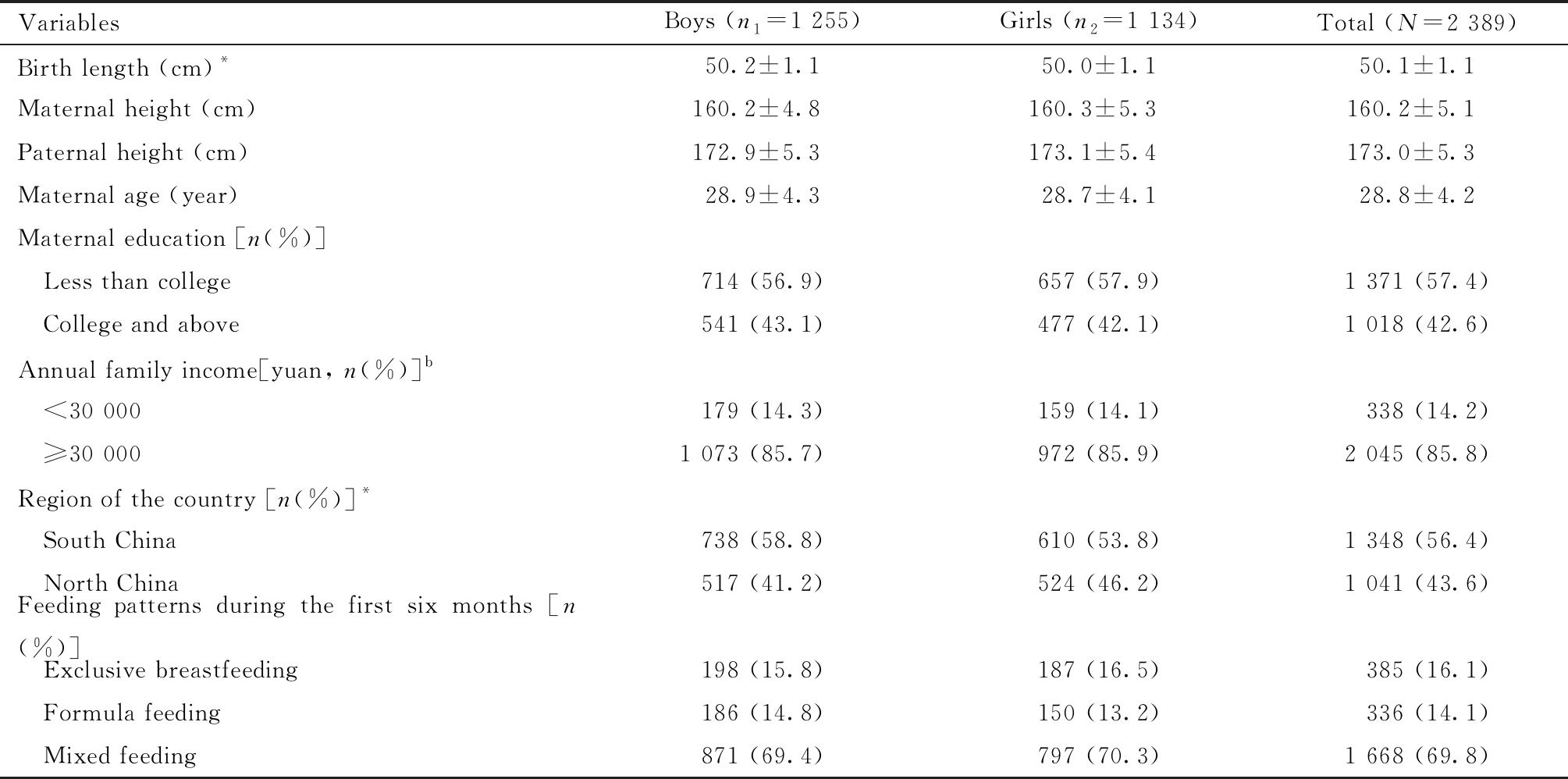婴儿期是儿童生长发育的重要时期,婴儿喂养,尤其是6月龄前纯母乳喂养,是儿童生长发育所需营养的物质基础[1]。世界卫生组织(World Health Organization,WHO)和联合国婴儿基金会(The United Nations Children′s Fund,UNICEF)建议在儿童前6个月坚持纯母乳喂养,并继续母乳喂养至2岁或2岁以上[2]。尽管如此,由于母亲乳汁含量不足、患身体疾病等原因不能够满足儿童需求或无法进行母乳喂养时,则采用配方奶粉等代乳品进行混合喂养或人工喂养[3]。身长/身高可反映儿童骨骼生长情况及长期营养状态,是生长发育的重要指标[4]。目前,关于不同喂养方式对婴儿身长的影响,结果不尽一致。有研究表明[5],纯母乳喂养和人工喂养婴儿身长差异无统计学意义。也有研究表明[6],混合喂养或人工喂养婴儿6个月后身长高于纯母乳喂养婴儿。因此,本研究使用2015年9月至2019年6月中国疾病预防控制中心妇幼保健中心开展的母婴健康动态追踪监测项目调查数据,探讨6月龄前不同喂养方式对0~12月龄婴儿身长的影响,以期为开展婴儿营养与健康促进工作提供数据支持。
资料与方法
一、资料来源
采用“母婴健康动态追踪监测项目”的随访调查资料。该项目由中国疾病预防控制中心妇幼保健中心于2015年9月至2019年6月开展,选取了南、北方地区共5个监测区县,北方监测地区包括河北省石家庄市正定县,辽宁省鞍山市立山区;南方监测地区包括福建省厦门市海沧区、集美区,湖南省岳阳市岳阳县;每个监测区县选取2~5个社区(乡镇)为监测点,并选择符合条件的孕晚期孕妇及所生儿童作为监测对象。项目最终共募集2 731对母婴,并追踪随访观察至儿童满3周岁。
二、研究对象
本研究对象为上述项目中0~12月龄婴儿。为保证婴儿体格发育同质性,在纳入的2 731例婴儿中,剔除了早产儿(97例)、分娩过程出现新生儿窒息者(20例)、出生缺陷者(10例)、低出生体重儿(35例)、巨大儿(135例)共297例婴儿,45例婴儿因无法进行喂养方式界定也予以剔除,实际最终共纳入2 389例婴儿进行分析。
三、 研究方法
1. 婴儿体格测量:婴儿出生身长、出生体重由助产机构进行测量。按照国家基本公共卫生服务的相关要求,在婴儿5个随访时间点(1、3、6、8、12月龄)由经过培训并合格的监测社区(乡镇)婴儿保健人员进行身长测量并记录。所有体格检查均按照2012年《儿童健康检查服务技术规范》要求严格操作[7]。
2. 问卷调查及内容:采用中国疾病预防控制中心妇幼保健中心设计并修订的调查问卷,包括《孕晚期孕妇健康状况调查表》和《儿童随访调查表》,由监测点调查员对监测孕妇进行一对一当面调查,收集孕妇个人及家庭基本情况等信息,并在婴儿3个随访时间点(1、6、12月龄)同时进行看护人一对一当面随访调查,获得婴儿养育情况和喂养情况等信息。
3. 喂养方式相关定义:参照WHO和UNICEF 2021年更新的《婴幼儿喂养评估指标》定义[8],并结合项目所获得的婴儿6月龄时喂养信息,将6月龄前喂养方式分为纯母乳喂养、人工喂养、混合喂养。(1)纯母乳喂养。6月龄时仍未断母乳,并未给其他任何乳类或代乳品,也未添加辅食。(2)人工喂养。指6月龄时完全用其他乳类或代乳品喂养,从未母乳喂养;(3)混合喂养。指6月龄时喂母乳的同时加用其他乳类或代乳品。
4.质量控制:本研究基于的母婴健康动态追踪监测项目由省、市级和区县级项目负责人员、项目专家技术指导小组成员组成质控小组开展现场质控工作。质控内容包括(1)体格检查技术操作的规范性;(2)随访调查表填写的完整性、规范性、真实性;(3)数据录入的及时性、准确性、一致性等,以确保数据准确无误。
5. 统计学处理:采用SAS 9.4对数据进行统计学分析。计数资料的描述采用例数和构成比[例(%)],计量资料的描述采用均数±标准差。由于本研究数据是典型的重复测量数据,同一婴儿不同随访时间点的测量值之间是非独立的,后一次测量值可能受前一次测量值影响,且随访时间间隔可能不完全相同,在随访过程中,漏查和失访情况难以避免,导致不同婴儿随访时间和次数不尽相同,为非平衡数据,传统统计分析方法诸如重复测量资料的方差分析等已不适用。因此,本研究采用多水平模型进行数据分析,以随访时间(月龄)为水平1,婴儿为水平2,构建时间-婴儿两水平生长模型,考虑儿童生长随时间变化呈非线性的发展规律,模型具体形式如下[9]:
式中i=1,2,3,…,n,表示水平1单位(随访时间);j=1,2,3,…,J,表示水平2单位(婴儿);yij为第j个婴儿的第i次随访时间身长测量值;βp为婴儿的平均身长生长量;tij为第j个婴儿的第i次随访时间;αp为婴儿6月龄前喂养方式对婴儿身长的影响大小;Z为婴儿6月龄前喂养方式;γp为6月龄前喂养方式随时间变化对婴儿身长影响情况;upj为第j个婴儿的身长与平均身长的差量,又称第二水平上的残差;eij为随机误差项,又称第一水平上的残差。H0为固定效应阶数,H1为随机效应阶数。采用SAS 9.4中的Proc Mixed过程进行模型拟合和参数估计[10],设检验水准α=0. 05。以1、3、6、8、12月龄的身长为结局变量,随访时间及6月龄前的喂养方式为固定效应,随访时间和婴儿个体为随机效应。本研究当随访时间(月龄)在固定效应取3次多项式,在随机效应为线性时,模型拟合效果最好(χ2=9 294.66,P<0.05,-2LL(IGLS)=44 081.00)。
结 果
一、监测地区婴儿基本情况
纳入的2 389例婴儿中,男童多于女童,男女比例为1.11∶1。男童出生身长高于女童(P<0.05)。婴儿母亲平均身高(160.2±5.1) cm,父亲平均身高(173.0±5.3)cm,母亲分娩年龄(28.8±4.2)岁,母亲文化程度大专以下居多,家庭年收入主要为≥3万。南北方监测地区婴儿占比分别为56.4%、43.6%。6月龄前喂养方式以混合喂养为主,占69.8%,纯母乳喂养占16.1%,人工喂养占14.1%。见表1。
表1 监测地区婴儿基本情况
Table 1 baseline characteristics of the infants in monitoring regions

ttest was used for comparing boys and girls in basic situation, *P<0.05; b The missing data of annual family income was 6 cases (0.2%)
Variables Boys (n1=1 255)Girls (n2=1 134)Total (N=2 389)Birth length (cm)*50.2±1.150.0±1.150.1±1.1Maternal height (cm)160.2±4.8160.3±5.3160.2±5.1Paternal height (cm)172.9±5.3173.1±5.4173.0±5.3Maternal age (year)28.9±4.328.7±4.128.8±4.2Maternal education [n(%)] Less than college714 (56.9)657 (57.9)1 371 (57.4) College and above541 (43.1)477 (42.1)1 018 (42.6)Annual family income[yuan, n(%)] b <30 000179 (14.3)159 (14.1)338 (14.2) ≥30 0001 073 (85.7)972 (85.9)2 045 (85.8)Region of the country [n(%)]* South China738 (58.8)610 (53.8)1 348 (56.4) North China517 (41.2)524 (46.2)1 041 (43.6)Feeding patterns during the first six months [n(%)] Exclusive breastfeeding198 (15.8)187 (16.5)385 (16.1) Formula feeding186 (14.8)150 (13.2)336 (14.1) Mixed feeding871 (69.4)797 (70.3)1 668 (69.8)
二、6月龄前不同喂养方式下0~12月龄婴儿各随访点身长水平
婴儿身长测量结果显示,出生、1、3、6月龄不同喂养方式婴儿身长水平相近(P>0.05),研究对象纯母乳喂养组婴儿身长略高于混合喂养组,差值范围为0~0.1 cm, 也略高于人工喂养组婴儿,差值范围为0.1~0.3 cm。8、12月龄人工喂养组婴儿身长则逐渐高于混合喂养组和纯母乳喂养组婴儿(P<0.05),差值范围分别为0.2~0.3 cm、0.1~0.7 cm。经两两比较(SNK法),女童8月龄混合喂养组和人工喂养组间、男童12月龄纯母乳喂养组和人工喂养组间身长差异均有统计学意义(P<0.05)。见表2。
表2 不同喂养方式下0~12月龄婴儿各随访点身长测量值![]()
Table 2 The average length at each time point of follow-up among different feeding infants aged 0-12 ![]()

Each time point of follow-up (0, 1, 3, 6, 8, and 12 months of age) of levels of length of infants of different gender were assessed among different feeding patterns using analysis of variance, *P<0.05. The SNK method was used for comparison between two groups,  the difference between mixed feeding and formula feeding girls was statistically significant (P<0.05), †the difference between exclusive breastfeeding and formula feeding boys was statistically significant (P<0.05).
the difference between mixed feeding and formula feeding girls was statistically significant (P<0.05), †the difference between exclusive breastfeeding and formula feeding boys was statistically significant (P<0.05).
Follow-up points(months)Number of follow-up casesBoysExclusive breastfeedingMixedfeedingFormulafeedingGirlsExclusive breastfeedingMixedfeedingFormulafeeding02 38950.3±1.050.2±1.150.2±1.150.0±0.850.0±1.150.0±1.412 38855.4±1.555.3±1.755.1±1.854.5±1.754.4±1.754.4±1.532 38862.7±2.062.7±2.062.5±2.261.5±2.361.3±2.061.2±2.062 38968.7±2.268.9±2.368.9±2.467.4±2.467.2±2.267.3±2.682 37571.5±2.271.7±2.471.9±2.770.5±2.670.1±2.370.6±2.3*‡122 34076.0±2.676.3±2.576.7±2.8*†75.0±2.775.0±2.475.4±2.7
三、6月龄前不同喂养方式对0~12月龄婴儿身长整体影响的模型拟合结果
模型分析显示,调整婴儿、母亲及家庭特征后,6月龄前不同喂养方式对0~12月龄婴儿身长的整体影响存在差异(P<0.05),且与时间存在交互作用(P<0.05)。在1月龄时,纯母乳喂养和混合喂养婴儿平均身长分别高于人工喂养婴儿0.627 cm、0.284 cm;6月龄时,纯母乳喂养和混合喂养婴儿平均身长分别高于人工喂养婴儿0.247 cm、0.009 cm。之后随着婴儿月龄的增长,纯母乳喂养婴儿和混合喂养婴儿平均身长逐渐低于人工喂养婴儿,人工喂养婴儿平均身长分别于7、10月龄逐渐高于混合喂养和纯母乳喂养婴儿。在12月龄时,人工喂养婴儿平均身长分别高于纯母乳喂养和混合喂养婴儿0.209 cm、0.321 cm。见表3。
在调整的因素中,婴儿性别、出生身长、母亲身高、父亲身高、所属地区对身长均有影响(P<0.05)。相比于女童,男童身长较高;出生身长越长、母亲或父亲身高越高,婴儿身长越高。相比于南方监测地区,北方监测地区婴儿身长较高。见表3。
表3 6月龄前不同喂养方式对0~12月龄婴儿身长影响模型参数估计值及分析结果
Table 3 The associations of feeding patterns during the first 6 months with the length of infants aged 0-12 months

FactorsCoefficientS.E.tPFixed Effects Intercept4.6181.7062.710.007 Age5.0780.037137.82<0.0001 Age2-0.4360.007-66.74<0.0001 Age30.0160.00048.89<0.0001 Feeding patterns (Exclusive breastfeeding)0.7030.1793.93<0.0001 Feeding patterns(Mixed feeding)0.3390.0913.73<0.001 Feeding patterns*Age (month)(Exclusive breastfeeding)-0.0760.015-5.10<0.0001 Feeding patterns*Age (month)(Mixed feeding)-0.0550.012-4.59<0.0001 Gender (Boy)1.1860.05920.24<0.0001
表3(续)

This model adjusted for characteristics of infants (including gender, birth length, and timing for introducing complementary foods), characteristic of families (including maternal height, paternal height, maternal education, and annual family income, and region of the country) and the interaction between feeding patterns during the first six months and age (time). *Z-value is used to test the significance of parameter estimates of random effects.
FactorsCoefficientS.E.tP Timing for starting complementary food (>6 months) -0.2360.147-1.600.109 Birth length (cm)0.4950.02718.49<0.0001 Maternal height(cm)0.0770.00612.38<0.0001 Paternal height (cm) 0.0450.0067.67<0.0001 Maternal education (Less than college)0.0570.0600.950.343 Annual family income (≥30000 yuan)0.1250.0851.470.142 Region of the country (North)0.5860.0639.23<0.0001Random Effects Level 2(σ2u0)1.4190.06820.92*<0.0001 Level 2(σ2u1)0.0220.00119.17*<0.0001 Level 1(σ2e0)1.1930.02059.06*<0.0001-2LL(IGLS)42283.80
讨 论
一、多水平模型在儿童生长发育领域应用广泛
多水平模型又称随机效应模型(random-effect model)、随机系数模型(random coefficient model)、混合效应模型(mixed-effects model),是处理结局变量分布在行政区划内或地理区域内存在相关性(聚集性)特征的常用统计方法之一[11]。此外,多水平模型能够充分考虑同一研究对象研究特征在不同观测时间点间的内部相互联系和随时间变化的规律,也能够灵活处理个体观测时间间隔或次数不同、观测时间点的数据存在缺失的非平衡设计的数据,因此,该模型也越来越多的用于多次重复测量的非独立数据分析[12]。由于儿童生长发育研究中存在大量具有层次结构或重复测量的纵向非独立数据,多水平模型在儿童生长发育领域被广泛应用。Johnson等[13]构建时间(月龄)-儿童-家庭/学校三水平模型,探讨饮食、行为、学校体育活动等因素对4~12岁儿童BMI的影响;Yaya等[14]构建儿童-社区-国家三水平模型,调整儿童性别、年龄、出生国籍、调查年份等因素,分析人均国内生产总值 (GDP)对撒哈拉以南非洲地区20个国家共4 905 265例5岁以下儿童发育迟缓的影响。相比于国外,多水平模型在国内儿童生长发育中的研究和应用还相对较少,Zhang等[15]构建儿童-社区多水平模型,探讨社区层面因素对1 606名中国5~18岁儿童身高的影响;Luo等[16]构建时间-儿童两水平生长模型,控制儿童性别,出生体重、母亲文化程度、家庭收入等协变量,分析妊娠合并梅毒母亲对0~18月龄儿童身长和体重的影响;张莉等[17]构建时间(月龄)-儿童两水平模型,探讨影响0~12月龄婴儿体重生长的因素。本研究为儿童体格发育纵向研究,是典型的重复测量数据,应用了多水平模型,控制了遗传、营养、生活方式、地域等诸多因素,并考虑了喂养方式与时间的交互作用,提高了参数估计的有效性。
二、6月龄前坚持纯母乳喂养可能是为婴儿生长早期提供体格发育所需营养的最佳方式,提倡6月龄前纯母乳喂养的同时,也要重视及时、科学合理添加辅食。
本研究婴儿身长测量结果显示,不同喂养方式下,婴儿6个月前身长水平相近, 6个月后人工喂养婴儿身长高于纯母乳喂养和混合喂养婴儿。Xiaoli等[18]研究表明,6月龄前纯母乳喂养组婴儿3至6月龄身长生长水平高于混合喂养和人工喂养婴儿,6~12月龄人工喂养婴儿身长水平高于纯母乳喂养和混合喂养婴儿;一项基于中国2015年“第五次中国九市7岁以下儿童体格发育调查”数据资料分析[19],发现0~6月龄不同喂养方式婴儿身长水平相近,6~12月龄人工喂养婴儿身长水平高于母乳喂养婴儿,均与本研究结果一致。说明相较于组成成分和营养配比逐步优化的配方奶粉,母乳能够满足婴儿6个月前体格发育所需的营养需求,加之母乳中富含的生物活性因子等物质,能够为婴儿提供重要的免疫保护,提高抗感染能力,降低5岁以下儿童罹患腹泻、肺炎等感染性疾病的风险[20],以及母乳喂养能够增进母婴情感等诸多优势,说明6月龄前坚持纯母乳喂养可能是为婴儿生长早期提供体格发育所需营养的最佳方式。而随着婴儿月龄增长,需要添加辅食以满足婴儿营养需求,人工喂养婴儿更可能及时添加辅食[21],可能导致人工喂养儿童婴儿生长后期身长更长。
本研究模型分析结果显示,在调整婴儿、母亲及家庭特征后,6月龄前不同喂养方式下婴儿的身长生长模式不同。混合喂养组和纯母乳喂养组婴儿分别于7、10月龄前高于人工喂养婴儿,之后人工喂养婴儿身长更长,说明6月龄前坚持纯母乳喂养婴儿在婴儿生长早期身长更长,6月龄前人工喂养婴儿在婴儿生长后期(10~12月龄)身长更长。Tian等研究发现[22],在调整混杂因素后,6月龄前混合喂养或配方奶粉喂养儿童8~24月龄身长高于纯母乳喂养儿童,与本研究结果一致。研究表明,不同喂养方式的婴儿具有不同的身长增长模式与母乳和配方奶粉组成成分和喂养行为有关。相比于配方奶粉,母乳中的乳清蛋白更高,更容易被消化吸收[23];母乳中棕榈酸占比更低,更利于脂肪、钙等营养物质的吸收[24]。还有研究发现[25],母乳低聚糖(Human milk oligosaccharides,HMOs)与婴儿年龄别身长Z评分(LAZ)呈正相关。此外,研究发现[26],相比于纯母乳喂养婴儿,人工喂养婴儿的父母更关注辅食添加时间、种类等问题。周旭等[27]研究发现,母乳喂养儿童6~23月龄时最少膳食种类(MDD)、最少膳食频率(MMF)和最低可接受膳食(MAD)合格率低于人工喂养儿童,提示在提倡纯母乳喂养的同时,也要重视及时、科学合理的添加辅食。
研究结果还显示,婴儿性别、出生身长、父母亲身高、所属地区等因素与婴儿身长存在关联,提示儿童身长生长情况是遗传、营养、地理环境等多种因素共同作用的结果,与冯围围等[28]、Campos等[29]研究结果一致。
三、本研究的局限性
本研究依据于6月龄随访时点收集的喂养信息,来评定6月龄前的喂养方式,不可避免地影响数据准确性;也有研究建议4~6月龄开始添加泥糊状食物[30],而本研究纯母乳喂养婴儿为6月龄前未添加辅食,这可能会降低纯母乳喂养率。此外,随着年龄增长,固体食物等辅食则作为婴儿营养的主要来源,但在模型拟合过程中,仅调整了辅食添加的时间,并未控制辅食添加的种类、喂养频率等。另外,本研究未考虑婴儿疾病、睡眠时间等生活习惯等其他可能影响身长生长的因素,可能影响结果的准确性。
志谢:5省监测区县管理人员、婴儿保健人员、调查人员等相关工作者及参与研究的所有家庭。
1 中华预防医学会儿童保健分会.婴幼儿喂养与营养指南.中国妇幼健康研究,2019,30:392-417.
2 World Health Organization.Infant and young child feeding.https://www.who.int/news-room/fact-sheets/detail/infant-and-young-child-feeding.
3 Shi H,Yang Y,Yin X,et al.Determinants of exclusive breastfeeding for the first six months in China:a cross-sectional study.Int Breastfeed J,2021,16:40-51.
4 胡燕.体格生长评价—体重与身材测量的临床意义.中国实用儿科杂志,2019,34:823-825.
5 Bell KA,Wagner CL,Feldman HA,et al.Associations of infant feeding with trajectories of body composition and growth.Am J Clin Nutr,2017,106:491-498.
6 Kang S,Lee SW,Cha HR,et al.Growth in Exclusively Breastfed and Non-exclusively Breastfed Children:Comparisons with WHO Child Growth Standards and Korean National Growth Charts.J Korean Med Sci,2021,36:e315.
7 儿童健康检查服务技术规范(卫办妇社发[2012]49号).中国儿童保健杂志,2012,20:956-958.
8 World Health Organization.Indicators for assessing infant and young child feeding practices definitions and measurement methods.https://www.who.int/publications/i/item/ 978924001838 9.
9 杨珉.多水平统计模型在生长发育研究中的应用(一).中国卫生统计,1997,14:60-62.
10 冯国双.重复测量数据的常用统计分析方法.中华预防医学杂志,2020,54:804-812.
11 冯国双,罗凤基,主编.医学案例统计分析与SAS应用.第2版.北京:北京大学医学出版社,2015:234-257.
12 Goldstein H,Browne W,Rasbash J.Multilevel modelling of medical data.Stat Med,2002,21:3291-3315.
13 Johnson BA,Kremer PJ,Swinburn BA,et al.Multilevel analysis of the Be Active Eat Well intervention:environmental and behavioural influences on reductions in child obesity risk.Int J Obes (Lond),2012,36:901-907.
14 Yaya S,Uthman OA,Kunnuji M,et al.Does economic growth reduce childhood stunting? A multicountry analysis of 89 Demographic and Health Surveys in sub-Saharan Africa.BMJ Glob Health,2020,5:e2042.
15 Zhang Y,Wang H,Wang X,et al.The association between urbanization and child height:a multilevel study in China.BMC Public Health,2019,19:569-576.
16 Luo H,Qiu L,Wu Y,et al.Growth in syphilis-exposed and -unexposed uninfected children from birth to 18 months of age in China:a longitudinal study.Sci Rep,2019,9:4416-4425.
17 张莉,黄莉,熊昌辉,等.混合线性模型在婴幼儿生长发育研究中的应用.中国卫生统计,2015,32:10-13.
18 Xiaoli S,Weiyan H,Li D.Effects of Neonatal Feeding Patterns on Infant Health.Appl Bionics Biomech,2022,2022:2225415.
19 Zong XN,Li H,Zhang YQ,et al.Growth performance comparison of exclusively breastfed infants with partially breastfed and formula fed infants.PLoS One,2020,15:e237067.
20 Victora CG,Bahl R,Barros AJ,et al.Breastfeeding in the 21st century:epidemiology,mechanisms,and lifelong effect.Lancet,2016,387:475-490.
21 Wang L,van Grieken A,van der Velde LA,et al.Factors associated with early introduction of complementary feeding and consumption of non-recommended foods among Dutch infants:the BeeBOFT study.BMC Public Health,2019,19:388-399.
22 Tian Q,Gao X,Sha T,et al.Effect of feeding patterns on growth and nutritional status of children aged 0-24 months:A Chinese cohort study.PLoS One,2019,14:e224968.
23 Martin CR,Ling PR,Blackburn GL.Review of Infant Feeding:Key Features of Breast Milk and Infant Formula.Nutrients,2016,8:279-289.
24 Ahern GJ,Hennessy AA,Ryan CA,et al.Advances in Infant Formula Science.Annu Rev Food Sci Technol,2019,10:75-102.
25 Davis JC,Lewis ZT,Krishnan S,et al.Growth and Morbidity of Gambian Infants are Influenced by Maternal Milk Oligosaccharides and Infant Gut Microbiota.Sci Rep,2017,7:40466-40481.
26 Zielinska MA,Rust P,Masztalerz-Kozubek D,et al.Factors Influencing the Age of Complementary Feeding-A Cross-Sectional Study from Two European Countries.Int J Environ Res Public Health,2019,16:3799-3816.
27 周旭,方俊群,罗家有,等.湖南省贫困农村地区6~23月龄婴幼儿辅食喂养现状及相关因素.中华预防医学杂志,2017,51:58-64.
28 冯围围,黄小娜,王惠珊,等.农村4月龄内婴儿体格生长的影响因素分析.中国儿童保健杂志,2017,25:18-20.
29 Campos AP,Vilar-Compte M,Hawkins SS.Association Between Breastfeeding and Child Stunting in Mexico.Ann Glob Health,2020,86:145-158.
30 黄小娜,王惠珊,徐轶群,等.中国六省经济较好农村地区母乳喂养婴儿0~12月龄体格发育纵向随访研究.中华儿科杂志,2010,48:484-491.